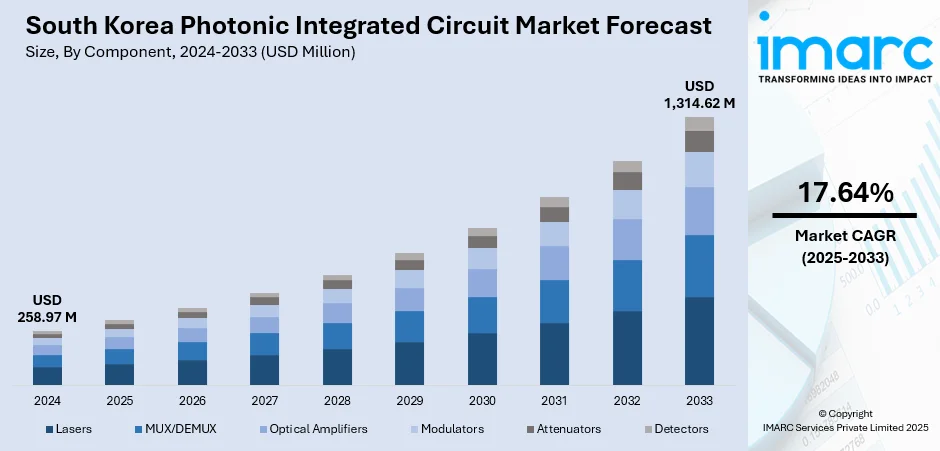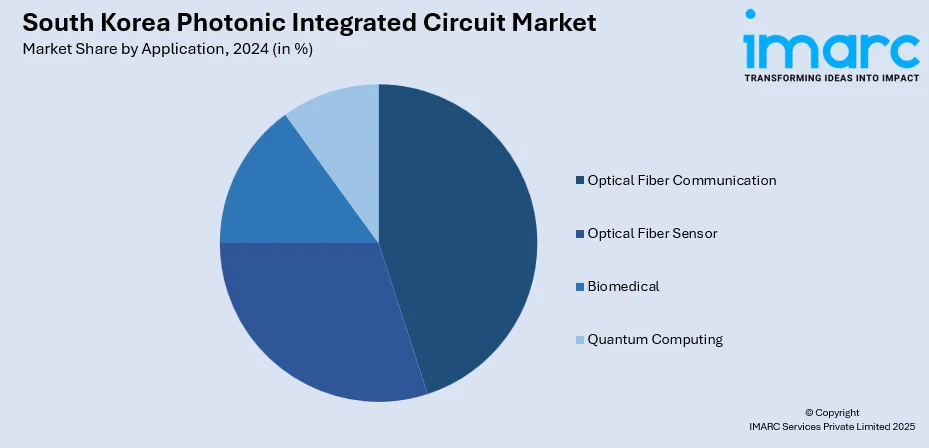
South Korea Photonic Integrated Circuit Market Size, Share, Trends and Forecast by Component, Raw Material, Integration, Application, and Region, 2025-2033
South Korea Photonic Integrated Circuit Market Overview:
The South Korea photonic integrated circuit market size reached USD 258.97 Million in 2024. Looking forward, IMARC Group expects the market to reach USD 1,314.62 Million by 2033, exhibiting a growth rate (CAGR) of 17.64% during 2025-2033. A robust semiconductor ecosystem, rapid 5G and AI deployment, state‑led R&D initiatives, and increasing automotive and telecommunications applications drive the market. Advanced packaging and optical module integration are spearheading technological progression, shaping South Korea photonic integrated circuit market share.
|
Report Attribute
|
Key Statistics
|
|---|---|
|
Base Year
|
2024
|
|
Forecast Years
|
2025-2033
|
|
Historical Years
|
2019-2024
|
| Market Size in 2024 | USD 258.97 Million |
| Market Forecast in 2033 | USD 1,314.62 Million |
| Market Growth Rate 2025-2033 | 17.64% |
South Korea Photonic Integrated Circuit Market Trends:
Integration with 5G and Next‑Gen Telecom
South Korea leverages its advanced 5G infrastructure to integrate photonic ICs into telecommunication systems. Leading chipset manufacturers are embedding PICs in optical backhaul and fronthaul modules to enable compact, energy‑efficient 5G base stations, boosting South Korea photonic integrated circuit market growth. Collaborative R&D between telecom giants and photonics startups yields high‑performance coherent transceivers and multi‑channel optical modules. Pilot programs facilitate field deployment, with modular optical units co‑packaged alongside silicon photonics and digital chips. As mobile data consumption and network densification rise, telecom operators increasingly adopt photonic integration to meet throughput demands while controlling power consumption. This trend underscores South Korea’s alignment of photonic technologies with national digital infrastructure goals. For instance, in December 2024, South Korea’s PhotoniSol, a startup from Inha University, developed the world’s first commercial optical isolator chip for silicon photonics. The chip enables hybrid integration with CMOS processes, reducing cost and size compared to traditional isolators. It targets use in data centers, LiDAR, and biosensors. Partnered with Singapore’s AMF for production, PhotoniSol aims to disrupt the optical transceiver market and expand globally with support from Korea’s deep tech initiatives.

To get more information on this market, Request Sample
Public‑Private R&D Consortia and Pilot Systems
South Korea’s photonic IC industry benefits significantly from government‑sponsored R&D consortia that unite universities, research agencies, conglomerates, and startups. These alliances focus on pilot production systems, packaging techniques, and standards development, underpinning South Korea photonic integrated circuit market growth. National grants support fabrication pilot lines and provide access to clean‑room facilities, enabling accelerated prototyping cycles. Corporations gain opportunities for early adoption trials, fostering smoother translation from lab to market. Collaboration frameworks prioritize IP sharing and commercialization pathways. Through these coordinated efforts, photonic integration technologies gain scale at lower cost, enhancing domestic supply chains. As a result, South Korea continues to strengthen its PIC competencies across research, manufacturing, and system‑integration layers. For instance, in November 2024, South Korea’s ETRI, with KAIST and University of Trento, developed an 8-photon silicon photonic quantum circuit achieving 6-qubit entanglement, aiming to scale to 32 qubits. This silicon photonics-based chip enables room-temperature, low-energy quantum computing. The chip integrates photon sources, filters, and switches for scalable photonic qubit control. Supported by Korea’s National Research Foundation, the initiative targets future cloud-based quantum systems.
South Korea Photonic Integrated Circuit Market Segmentation:
IMARC Group provides an analysis of the key trends in each segment of the market, along with forecasts at the country and regional levels for 2025-2033. Our report has categorized the market based on component, raw material, integration, and application.
Component Insights:
- Lasers
- MUX/DEMUX
- Optical Amplifiers
- Modulators
- Attenuators
- Detectors
The report has provided a detailed breakup and analysis of the market based on the component. This includes lasers, MUX/DEMUX, optical amplifiers, modulators, attenuators, and detectors.
Raw Material Insights:
- Indium Phosphide (InP)
- Gallium Arsenide (GaAs)
- Lithium Niobate (LiNbO3)
- Silicon
- Silica-on-Silicon
A detailed breakup and analysis of the market based on the raw material have also been provided in the report. This includes indium phosphide (InP), gallium arsenide (GaAs), lithium niobate (LiNbO3), silicon, and silica-on-silicon.
Integration Insights:
- Monolithic Integration
- Hybrid Integration
- Module Integration
The report has provided a detailed breakup and analysis of the market based on the integration. This includes monolithic integration, hybrid integration, and module integration.
Application Insights:

- Optical Fiber Communication
- Optical Fiber Sensor
- Biomedical
- Quantum Computing
A detailed breakup and analysis of the market based on the application have also been provided in the report. This includes optical fiber communication, optical fiber sensor, biomedical, and quantum computing.
Regional Insights:
- Seoul Capital Area
- Yeongnam (Southeastern Region)
- Honam (Southwestern Region)
- Hoseo (Central Region)
- Others
The report has also provided a comprehensive analysis of all the major regional markets, which include Seoul Capital Area, Yeongnam (Southeastern Region), Honam (Southwestern Region), Hoseo (Central Region), and others.
Competitive Landscape:
The market research report has also provided a comprehensive analysis of the competitive landscape. Competitive analysis such as market structure, key player positioning, top winning strategies, competitive dashboard, and company evaluation quadrant has been covered in the report. Also, detailed profiles of all major companies have been provided.
South Korea Photonic Integrated Circuit Market News:
- In November 2024, Amkor Technology and Lightmatter partnered to create the world’s largest 3D photonics package using Lightmatter’s Passage™ platform. This innovation integrates customer dies onto a silicon photonic interconnect for higher bandwidth and connection density, overcoming limitations of traditional electrical interposers. The 3D package boosts AI and HPC performance with enhanced energy efficiency and thermal management. This collaboration advances semiconductor packaging, enabling breakthroughs in AI computing and silicon density for future technologies like AGI.
- In June 2024, Intel demonstrated the industry’s first fully integrated optical compute interconnect (OCI) chiplet co-packaged with a CPU, enabling high-bandwidth, energy-efficient optical I/O for AI and high-performance computing. The chiplet supports 64 channels at 32 Gbps each, allowing up to 4 Tbps data transfer over fiber optics up to 100 meters. This innovation addresses AI infrastructure demands by boosting bandwidth, reducing power use, and extending reach, advancing scalable, efficient AI computing.
South Korea Photonic Integrated Circuit Market Report Coverage:
| Report Features | Details |
|---|---|
| Base Year of the Analysis | 2024 |
| Historical Period | 2019-2024 |
| Forecast Period | 2025-2033 |
| Units | Million USD |
| Scope of the Report |
Exploration of Historical Trends and Market Outlook, Industry Catalysts and Challenges, Segment-Wise Historical and Future Market Assessment:
|
| Components Covered | Lasers, MUX/DEMUX, Optical Amplifiers, Modulators, Attenuators, Detectors |
| Raw Materials Covered | Indium Phosphide (InP), Gallium Arsenide (GaAs), Lithium Niobate (LiNbO3), Silicon, Silica-on-Silicon |
| Integrations Covered | Monolithic Integration, Hybrid Integration, Module Integration |
| Applications Covered | Optical Fiber Communication, Optical Fiber Sensor, Biomedical, Quantum Computing |
| Regions Covered | Seoul Capital Area, Yeongnam (Southeastern Region), Honam (Southwestern Region), Hoseo (Central Region), Others |
| Customization Scope | 10% Free Customization |
| Post-Sale Analyst Support | 10-12 Weeks |
| Delivery Format | PDF and Excel through Email (We can also provide the editable version of the report in PPT/Word format on special request) |
Key Questions Answered in This Report:
- How has the South Korea photonic integrated circuit market performed so far and how will it perform in the coming years?
- What is the breakup of the South Korea photonic integrated circuit market on the basis of component?
- What is the breakup of the South Korea photonic integrated circuit market on the basis of raw material?
- What is the breakup of the South Korea photonic integrated circuit market on the basis of integration?
- What is the breakup of the South Korea photonic integrated circuit market on the basis of application?
- What is the breakup of the South Korea photonic integrated circuit market on the basis of region?
- What are the various stages in the value chain of the South Korea photonic integrated circuit market?
- What are the key driving factors and challenges in the South Korea photonic integrated circuit market?
- What is the structure of the South Korea photonic integrated circuit market and who are the key players?
- What is the degree of competition in the South Korea photonic integrated circuit market?
Key Benefits for Stakeholders:
- IMARC’s industry report offers a comprehensive quantitative analysis of various market segments, historical and current market trends, market forecasts, and dynamics of the South Korea photonic integrated circuit market from 2019-2033.
- The research report provides the latest information on the market drivers, challenges, and opportunities in the South Korea photonic integrated circuit market.
- Porter's five forces analysis assist stakeholders in assessing the impact of new entrants, competitive rivalry, supplier power, buyer power, and the threat of substitution. It helps stakeholders to analyze the level of competition within the South Korea photonic integrated circuit industry and its attractiveness.
- Competitive landscape allows stakeholders to understand their competitive environment and provides an insight into the current positions of key players in the market.
Need more help?
- Speak to our experienced analysts for insights on the current market scenarios.
- Include additional segments and countries to customize the report as per your requirement.
- Gain an unparalleled competitive advantage in your domain by understanding how to utilize the report and positively impacting your operations and revenue.
- For further assistance, please connect with our analysts.
 Request Customization
Request Customization
 Speak to an Analyst
Speak to an Analyst
 Request Brochure
Request Brochure
 Inquire Before Buying
Inquire Before Buying




.webp)




.webp)












